What worked and what didn’t: Learning from other cities
When you’re about to spend a lot of money on a big investment that’s intended to improve your quality of life, you probably don’t go into the situation without doing some research first. Whether it’s buying a home or helping your kid choose a post-secondary education option, you’ve likely asked questions about the value of your investment. Maybe you talked with friends and family, read reviews, and looked at projections of how that investment would pay off over time.
It’s not so different as Charlotte begins to consider the best way to create a plan for advancing mobility in our city. And just as importantly, how to pay for it over time. What will it take to champion a winning investment that voters are excited to support?
As the Charlotte Moves Task Force moves closer to their goal of recommending a comprehensive package of mobility projects and recommending a funding source, they’re beginning to look to peer cities that are also facing incredible population growth and mobility challenges.
At their July 23 meeting, the Task Force heard from a panel of transportation staff in 3 peer communities: Broward County (FL), Austin (TX), and Nashville (TN).
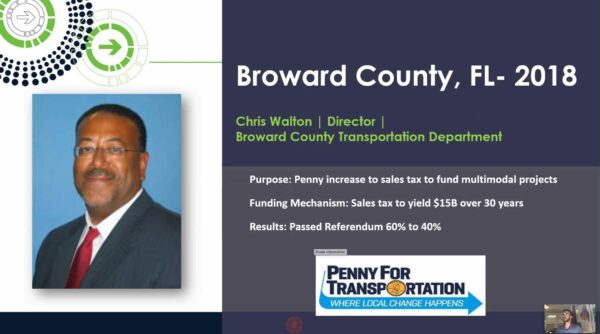
Broward County: Third Time’s a Charm
After failed transportation funding campaigns in 2006 and 2016, Broward County successfully passed a referendum in 2018 with a 60% to 40% vote. What were their keys to success the third time?
- “Our residents wanted more.” said Broward County Transportation Department Director Chris Walton. The 2018 campaign championed a comprehensive package of projects to improve traffic congestion and connectivity. It included not only bus and light rail, but also greenways, bike paths, street lighting, pedestrian improvements, and resiliency projects to protect this coastal community’s transportation network during high tides.
- They mapped out a plan for the region and then determined the cost. This included increasing the bus system from 350 to 622 buses, adding 26 miles of light rail, strategic road resurfacings and widenings over 30 years, as well as the previously mentioned projects. Based on the projected cost, a one penny sales tax was chosen as the right amount for the referendum because it would raise approximately $15.6 Billion over 30 years (assuming certain state and federal funding formulas remain).
- Winning over the 31 municipalities within Broward County was made possible by allowing 10% of the funding generated by the sales tax to be used on a project-by-project basis within those municipalities and overseen by a board. This built confidence within the leadership of the towns and their voters.
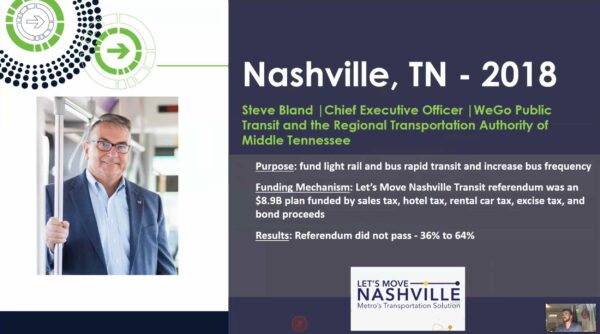
Nashville: What went wrong?
The 2018 Let’s Move Nashville Transit Referendum would have raised approximately $8.9 Billion over 15 years through sales and other taxes. Chief Executive Officer of WeGo Public Transit and the Regional Transportation Authority of Middle Tennessee Steve Bland shared the initial plan and ultimate weaknesses of Nashville’s strategy after the referendum failed by an overwhelming 36% to 64% vote.
- Was there too much focus on high-impact projects? Prior to the referendum campaign, Nashville had recently completed a variety of planning processes. Leaders looked at 3 possible spending scenarios: 1) just growing to meet the needs of the population based on current spending levels, 2) keeping up with peer cities, and 3) an aspirational transportation network. During outreach to the public and businesses, they got the message to “go big” with the aspirational plan. The most expensive part of the plan was to build 22 miles of light rail. Vocal opponents of the referendum pointed out this focus on big projects that would benefit downtown and the business community, and publicly stirred up doubt about whether smaller projects benefitting outlying neighborhoods would be prioritized and done in a timely manner.
- “We didn’t do a very good job convincing the 1/3 in the middle.” Outside influencers took advantage of a mayoral scandal and also convinced different communities that the referendum wasn’t a good deal for them. Read TransitCenter’s Derailed reportfor a comprehensive analysis of what went wrong in Nashville.
- Mr. Bland shared this advice for Charlotte: “Make sure your plan has broad-based benefits that can be easily communicated and account for whatever other hot button issues are in Charlotte.”
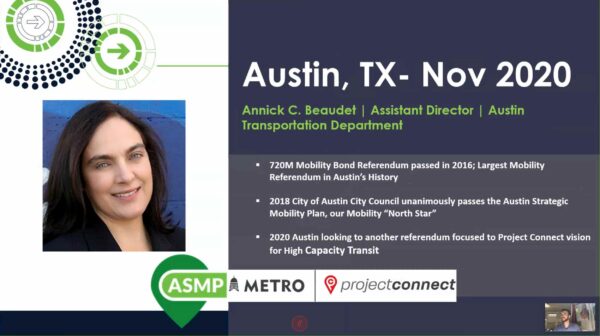
Austin: How will it unfold this fall?
Austin’s situation is perhaps closest to Charlotte’s. They completed a Strategic Mobility Plan in 2018 that Charlotte is now looking to as our “North Star”, including the 50/50 mode share goal (50% of trips taken by driving alone and 50% by sustainable modes like walking, biking, public transit, and carpooling). Austinites will go to the polls this fall to vote on a referendum for high capacity transit. Austin Transportation Department Assistant Director Annick Beaudet discussed how the city created a transportation vision and investment plan that they believe will be a “Yes” for most voters this year.
- Following Austin’s designation as one of the 10 most congested major metropolitan areas in the country, Austin’s mayor and city council declared 2016 to be the “Year of Mobility” and championed the successful $720 Million Mobility Bond Referendum — the largest in Austin’s history. They built on this momentum by creating and unanimously passing a very ambitious and highly actionable Strategic Mobility Plan in 2018. We’re so glad they did, because Charlotte is using it to guide the creation of our own plan!
- Ms. Beaudet stressed the importance of really getting out into each community to listen. “Talking to people is the best way to build support.” Austin has been doing public engagement with all communities, but especially those who often aren’t asked their opinions on transportation: seniors, youth, low-income residents, and people living in communities of color. She shared an example of residents in one district working with city staff to “dream up what could be” and seeing their project idea included in the final plan after she helped to champion it to her staff.
- Using a data-driven approach when engaging the public is critical. A 50/50 mode share goal is very ambitious and will have incredible environmental, equity, and economic mobility benefits for residents and the city as a whole. But it also recognizes that about 50% of people are still driving alone in their cars.
What do Charlotte Moves Task Force members have to say so far about their experience and transportation priorities? Here are some interesting poll results:
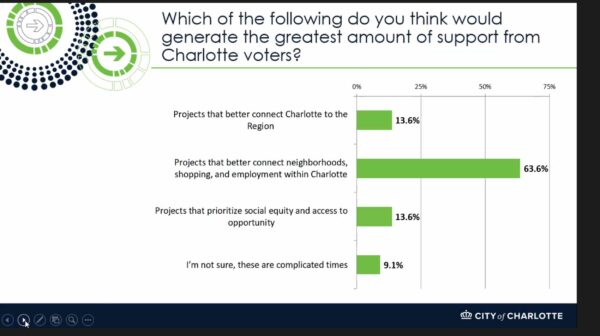
A poll of Charlotte Moves Task Force members prior to the meeting showed that an overwhelming majority — 63.6% — said that the projects likely to generate the most support from Charlotte voters are those “that better connect neighborhoods, shopping, and employment within Charlotte.” Tied for second place at 13.6% each were “Projects that better connect Charlotte to the Region” and “Projects that prioritize social equity and access to opportunity.” As was noted by the presenter, social equity and access to opportunity are likely to be inherent to projects that improve connectivity. In other words, these categories aren’t mutually exclusive.
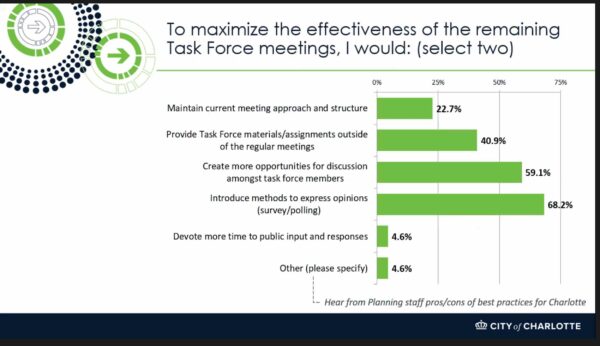
Task Force members were asked to choose two of the above options for maximizing the effectiveness of the remaining meetings. The two most popular answers were “Introduce methods to express opinions (survey/polling)” at 68.2%, and “Create more opportunities for discussion amongst Task Force members” at 59.1%.
You may share our frustrations over the challenges of public engagement as all meetings are now being held virtually. We know that’s necessary to keep us all healthy, and we’re glad City staff quickly pivoted to provide public access to the meetings in real-time via Facebook Live and YouTube. But it does make it difficult for Task Force members to have discussions amongst themselves, and even harder for the public to engage. We hope to see more opportunities for Task Force members to communicate and express their opinions. Even better, could the polling during the meetings include opportunities for the public to participate?
Charlotte Moves Task Force meetings are held monthly. The next meeting is scheduled for 6:00pm on Thursday, August 20. The public is welcome to watch the meetings live on the City’s YouTube channel and encouraged to submit questions by email in advance of, or during, the meetings. Learn more.
Thanks for reading!
As a nonprofit, community support is essential for us to keep doing what we do — including providing free articles like this. If you found this article helpful, please consider supporting Sustain Charlotte.
Want to stay in the loop? Subscribe to our weekly newsletter and follow us on Instagram, Facebook, and Twitter.
